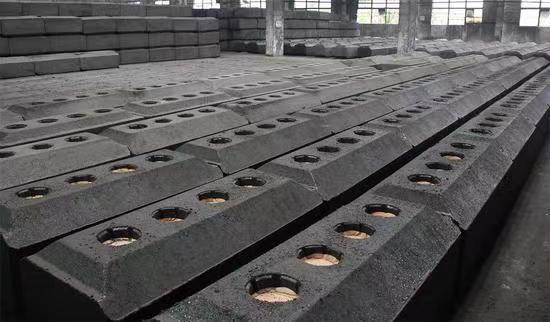Carbon anode scrap is a valuable but often overlooked by-product of aluminum production. It refers to the residual part after the prebaked anode carbon block is used on the electrolytic cell. By recycling this scrap, companies can help reduce their environmental impact and take advantage of potential benefits. This article discusses the uses, pricing, and benefits of recycling it.
Table of Contents
Toggle
What is carbon anode scrap?
Carbon anodes conduct electricity in the electrolytic cell and participate in the anode reaction, so they are constantly consumed, and carbon anode scrap is the result of this process.
It is a by-product of aluminum production when the raw material is melted and turned into the finished product. The residual anode is generally 15-25% of the amount of anode carbon block, which people can recycle.
Manufacturers divide scrap into hard and soft carbon anode scrap. Hard ones perform almost as well as anodes. The soft ones are noticeably different, heavily oxidized both inside and out.
Carbon anode scrap use.
It has a variety of uses in aluminum production and other industries. It is broken into medium and coarse particles after thoroughly removing the electrolyte from the surface. They can replace part of calcined coke or be used as raw materials for anode batching. In addition, factories can use it as a high calorific value smelting fuel.
The calorific value of the anode scrap is high, the heat can reach 8000 calories, and the carbon content is above 97%. The combustion value of 1 ton is equivalent to 1.5 tons of metallurgical coke.
Carbon Anode Scraps Prices.
The price of carbon anode scrap depends on the type and quantity of material purchased. Usually, the price depends on the scrap’s size, weight, and composition. Prices may also vary depending on the carbon anode scrap supplier’s location and the type of scrap purchased.
Typically, it costs between $0.10 and $1.00 per pound. Prices fluctuate with the market, so keeping an eye on current prices before buying is essential.
Applications and Benefits:
a. Recycling and Reuse:
Carbon Recovery: Carbon anode scrap can be recycled and processed to recover high-quality carbon materials. These materials can be reintroduced to produce new anodes, reducing the need for virgin carbon resources and minimizing waste.
Carbon Products: Carbon anode scraps can be further processed into various carbon-based products, such as electrodes, refractories, and carbon raisers, finding applications in steel manufacturing, foundries, and other industries.
b. Environmental Sustainability:
Waste Reduction: Utilizing carbon anode scrap reduces the waste generated in aluminum production and related industries. It promotes a circular economy by diverting scrap materials from landfills and lessening the demand for new carbon resources.
Energy and Emissions: The recycling and reuse of carbon anode scrap consume fewer energy resources compared to the production of virgin carbon materials. This leads to reduced greenhouse gas emissions and a smaller environmental footprint.
Steps Involved in Recycling.
Recycling carbon anode scrap is relatively easy and involves several steps. After replacing it with the electrolyzer, remove the electrolyte’s hard shell on its surface. It is then separated from the steel jaws using a machine or manually. Workers crushed, screened, and divided into different particle sizes during this process.
Workers should clean the anode scrap carefully because the electrolyte attached to its surface will affect carbon products’ conductivity and oxidation activity.
It is imperative to ensure the quality of the scrap as this will help ensure that the final product is also of good quality. Buyers make sure that carbon anode scrap suppliers are reliable and offer competitive prices. Then factory packaged that scrap correctly and shipped on time.
Conclusion
By following these steps, companies can ensure they get the most out of their scrap and maximize its value. Are you interested in learning more about carbon anode scrap and how to maximize its value? Contact us today to learn more!

